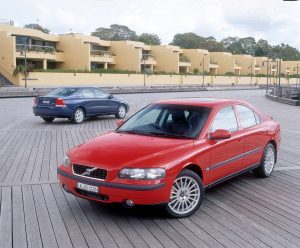Recalls: Volvo Mk.1 S60
Overview
Manufacturers, or importers, issue recalls for defects or faults which have the potential to cause injury. Generally, manufacturers will inform the original buyers if their vehicle is subject to a recall and of the steps required to remedy the defect or fault. Please note that the recalls below (if any) are for Australian-delivered vehicles only. Furthermore, the number of recalls should not be taken as an indication of a model’s reliability or its safety more generally.
Recalls: Volvo Mk.1 S60
2004 model year Volvo S60: control arms not to specification
In January 2004, a recall was issued for 2004 model year Volvo S60 vehicles due to the front control arms not having been manufactured to specifications. As a result, the stud and nut which secured the front control arm to the spindle may lose its initial axial tension and cause the steering wheel to go out of alignment – this may create front suspension noise. Under certain conditions, the vehicle may become less responsive and the driver may experience steering wheel play. At worst, the front control arm and spindle may separate. The corrective action was to exchange the nuts and increase the assembly torque on affected vehicles (PRA 2004/6737).
2001 model year Volvo S60: cooling fan may overheat
In September 2004, a recall was issued for certain model year 2001 Volvo S60 vehicles. In certain operating conditions, the electric cooling fan may overheat, potentially destroying the fan and nearby components. In some cases, a fire in the engine compartment may result. The recall required that the electric cooling fan be replaced with an improved unit (PRA 2004/7244).
2001-04 Volvo Mk.1 S60: Takata airbag recall
In November 2020, recall campaign R10058 was issued for Volvo S60 vehicles that were available for sale in Australia from 1 May 2001 to 1 December 2004. In these vehicles, propellant wafers in the driver’s airbag inflator could absorb moisture over time. This could cause excessive internal pressure in the event of airbag deployment, such that the airbag inflator housing could rupture and project metal fragments through the airbag cushion and into the vehicle’s cabin. These metal fragments posed a risk of serious injury and fatality. For the VINs of the recalled vehicles, please see PRA 2020/18659.
Problems and faults: Volvo Mk.1 S60
Overview
This section identifies potential problems, causes and fixes based on the experiences of owners and repairers, online sources and technical service bulletins. This information is provided solely for reference purposes and AustralianCar.Reviews recommends that only properly qualified persons carry out repairs or modifications. Furthermore, the number of items below should not be taken as an indicator of a model’s reliability or the frequency with which they may occur.
To report a problem or fault to the AustralianCar.Reviews team, please use the Contact Us form. Note that AustralianCar.Reviews does not offer advice on automotive problems or disputes; such enquiries will not receive a reply. For vehicles purchased from dealers after 1 January 2011, please see our Australian Consumer Law fact sheet.
2001-02 Volvo S60: electronic throttle control software update – service campaign
In November 2006, Volvo initiated recall R155 in the USA to update the electronic throttle control software; while this recall was not initiated in Australia, a service campaign was. According to the recall notice, all 2001 model year Volvo S60 vehicles and 2002 model year Volvo S60 vehicles with naturally aspirated engines vehicles may experience the following symptoms:
- Entering ‘limp home’ mode (which limited power and engine speed); and/or,
- A warning lamp in the instrument cluster would illuminate and the ‘Service Required’ message would be displayed.
The recall notice attributed these symptoms to a combination of throttle positioning sensor irregularities, a dirty throttle housing and/or ‘inefficient’ software calibration. The electronic throttle control software upgrade that was installed as part of the recall enabled the system to better differentiate between glitches or minor disturbances, and real system faults. The software upgrade also reduced idle oscillations caused by dirt build-up in the throttle.
Itis understood that the service action for Australian-delivered vehicles included:
- Measuring pressure in the crankcase and cleaning the crankcase ventilation system. According to Volvo Cars Australia, a ‘high percentage’ of Volvo cars serviced outside its dealer service network experienced blocked crankcase breathers;
- Updating the electronic throttle module (ETM) software as per the R155 recall; and,
- Clearing any fault codes in the system.
2001-04 model year Volvo S60: cracks in fuel pump flange
In 2010, Volvo UK issued a ‘non-code action’ for 2001-04 model year Volvo S60 vehicles. In these Volvo S60 vehicles, certain environmental conditions, i.e. hot climate and temperature cycling, combined with varying fuel quality could cause the fuel pump to develop cracks in the fuel pump flange. If this occurred, the driver may detect a fuel smell, while a fuel leak could also occur and pose a fire hazard (NCA/2010/019). In the USA, an official safety recall was issued for this concern (NHTSA Campaign Number 09V483000).
Volvo S60: engine won’t start
The Volvo S60’s engine may not start if the fuel level is low and the vehicle is parked facing downhill due to the design of fuel pump. Later models had a redesigned pump with an anti-siphon valve. High temperatures and humidity may contribute to short alternator life, but an upgraded regulator may fix the problem.
Problems and faults: Volvo Mk.1 S60
- Oil may leak from the differential vent – replacement vent valves are available.
- For Volvo S60 AWD models, a squealing or rubbing noise that occurs after driving through a puddle is caused by the exhaust pipe temporarily warping and touching the driveshaft. An additional exhaust hanger can be fitted to solve the problem.
- For turbocharged models, the clutch pedal may vibrate due to the hydraulic fluid transmitting pressures; a hydraulic line with a loop that absorbed the vibrations was subsequently released.




